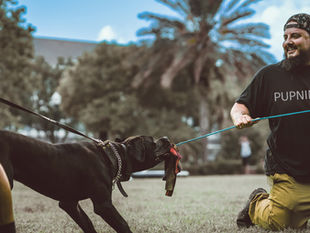Raising a dog today often comes from a place of deep love. They’re our companions, our “fur babies,” and in many cases, they feel like our kids. But here’s the tough truth: Our nurturing instincts—though well-intentioned—can unintentionally hold our dogs back.
The Balance Between Comfort and Confidence
Dogs are animals, not little humans. They’re wired for structure, challenge, and clear leadership. When we over-coddle them—constantly shielding them from stress, indulging every behavior, or babying them through fear—we rob them of the very experiences that build confidence.
A dog that never faces frustration, boundaries, or the opportunity to work through discomfort doesn't grow into a stable, resilient companion. Instead, they stay emotionally immature, easily overwhelmed, and often reactive.
The Problem Compounds During Training
When a dog isn’t used to handling pressure—whether from boundaries, corrections, or just being told “no”—they struggle to adapt during formal training. Trainers often have to increase levels of compulsion (pressure, leash corrections, tools) not because they want to, but because it’s the only way the dog understands that a rule exists.
The dog isn’t being defiant; they’re just emotionally soft from an upbringing that avoided challenge.

The “Where’s My Mom?” Effect
We see it all the time in our Board & Train programs.
A dog comes in with big feelings, zero coping skills, and one major question:“Where’s my mom, and why isn’t she rescuing me right now?”
Instead of adapting to the structure of training, many dogs shut down, whine, or resist—not because they’re being mistreated, but because they’ve been conditioned to expect constant emotional support.
They’re used to being picked up, soothed, and bailed out the moment they show discomfort. So when they’re finally asked to think, cope, or follow through without help, they melt down.
This slows progress, creates confusion, and ironically leads to more pressure being needed just to get through the basics. Not because we’re being harsh—but because the dog never learned how to deal with limits without their human as a buffer.
The fix? Raising dogs to be emotionally prepared for life—not just comforted through it.
Start Early, Raise Right
One of the biggest mistakes we see? Waiting too long to teach independence, boundaries, and problem-solving.
The truth is, the earlier a puppy is taught how to handle pressure, separation, and structure, the less “correction” or “compulsion” they’ll ever need later.
That’s why we created a PupNinja program specifically for puppies and newly adopted dogs. It’s designed to lay the emotional foundation—confidence, resilience, patience—that makes obedience training smoother and less stressful down the line.
Take crate training, for example.
Most people introduce the crate as either a punishment or a “babying” tool. But done wrong, it just teaches the dog to panic when left alone. It doesn’t build coping skills.
When done right, crate training teaches a puppy:🧠 “I can be calm and alone.”💪 “I can wait.”🐾 “I don’t need someone with me 24/7 to feel safe.”
Real-World Impact: The Vet Example
Still not sure why it matters?
Imagine your dog needs to stay overnight at the vet due to an illness or injury. They’re already not feeling well. Their body is stressed.
Now add a second layer of stress: They’ve never been crated without you. They panic. They bark, scream, bite at the door, or shut down entirely.
Instead of coping with just their illness, they’re now battling emotional distress on top of physical discomfort—all because they were never taught how to be alone, how to self-soothe, or how to feel secure without you.
This is why raising a dog properly—teaching independence, patience, and calmness early on—isn’t just about obedience. It’s about resilience.
It’s about preparing them for the unpredictable.
And when you do that?
You create a dog that doesn’t fall apart every time life gets uncomfortable. A dog that can face the world—even the hard parts—with clarity and confidence.
It’s like kids staying overnight at a friend’s house for the first time. At first, it’s uncomfortable—but it’s a critical step in learning independence.
Our goal isn’t just to train a puppy. It’s to raise a dog who’s confident in the world, even when you’re not holding their paw.
What “Correct Raising” Looks Like
Confidence comes from exposure. From being told “you can figure this out.” From being taught limits and seeing what happens when they push them.
Here are a few examples:
Set boundaries early. Don’t wait until the behavior is intolerable to say “no.”
Expose, don’t protect. Let them see the world. Hear noises. Tolerate dogs. Struggle a little.
Let frustration happen. A dog learning to wait, hold a command, or deal with not getting their way is developing patience and impulse control.
Stop interpreting everything through a human lens. Your dog doesn’t need to be constantly reassured. They need to be led.
The Goal: Calm, Stable, Confident
At PupNinja, we help bridge the gap between how you raise your dog and how you train them. Our programs aren’t just about commands—they’re about mindset, habits, and lifestyle.
When dogs are raised with the right blend of nurture and structure, training becomes clearer, smoother, and less reliant on compulsion. You get faster results, and your dog gets a life of calm confidence.














